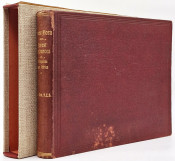First edition: 166 pages of letterpress, 100 plates of line drawings, original brown cloth, titled gilt on the spine, top and bottom of the spine worn and small stains on the upper cover, some light foxing on the half title and title pages, otherwise the contents and plates are in very good condition, contained in a brown cloth slip case.
(https://www.s2a3.org.za/bio/Biograph_final.php?serial=2584), 'Thomas R. Sim was the son of John Sim, a farmer, plant collector and authority on mosses, and his wife Isabella Robertson. He was the eldest brother of the forest officer James M. Sim. Thomas attended school in Aberdeen until 1872 and attended some classes in botany and agriculture at Marischal College in that city, but was largely self-taught. He was apprenticed as a gardener in the Royal Horticultural Society's garden at Chiswick, London, in 1874, and in February 1878 started work at the Royal Botanical Gardens at Kew, near London, where he received some training in botany under Sir Joseph Hooker. In January1879 he went to the United States, working for a year in the botanic gardens of Harvard University in Cambridge, Massachusetts, and then at a private establishment. At Harvard he attended lectures in botany by Professor Asa Gray and others. The influence of Hooker and Gray, both great systematists, was later clearly reflected in Sim's published work. He returned to Scotland in 1881 to farm with his father in Aberdeenshire. From 1884 to 1888 he was a fruit farmer at Inchmark. In 1882 he married Margaret R. Wilson, with whom he had two sons and a daughter.
'Sim came to South Africa in 1889 to take up the post of curator of the King William's Town botanical gardens. His interest initially centred around the ferns of the region and from 1891 he presented ferns and other botanical specimens to the Albany Museum in Grahamstown. Only two years after his arrival he published a Handbook of the ferns of Kaffraria... (Aberdeen, 1891). This was soon followed by a more comprehensive work, The ferns of South Africa, containing descriptions and figures of the ferns and fern allies of South Africa, with localities, cultural notes, etc (Cape Town, 1892; 2nd ed., Cambridge, 1915). The book was illustrated with his own line-drawings. Two years later he published Sketch and check-list of the flora of Kaffraria... (Cape Town, 1894), based on a paper he read before the King William's Town Naturalists' Society in July 1893. He participated in the society's activities and in 1896 contributed specimens to its museum (later the Kaffrarian Museum)......
'On the basis of his work in the Eastern Cape Sim was transferred to Natal as conservator of forests for that colony in September 1902, a post that had been abolished with the resignation of F. Schöpflin in 1893. His brief was to re-establish a Forestry Department in Natal. He soon re-organised the forest service, issued regulations for the protection and utilisation of crown forests, and planted and named an arboretum of about 400 species of trees and shrubs at Cedara, the agricultural research station near Howick. In 1907 he published The forests and forest flora of the Colony of the Cape of Good Hope (Aberdeen, 1907, 361 pp), the first comprehensive work on South African trees, with his own line drawings of 312 species. It provided a useful, though cumbersome handbook for the Forestry Department and is a monument to Sim's industry and perseverance. In 1908 he presented herbarium specimens of the family Thymelaeceae (small trees and shrubs) to the South African Museum. That same year, as an advisor to the government of Portuguese East Africa (now Mozambique), he made an extensive and arduous exploration of the forests of that country and wrote Forest flora and forest resources of Portuguese East Africa (Aberdeen, 1909), again illustrated with his own sketches. He also published papers and notes on various topics in the Agricultural Journal of the Cape of Good Hope and the Natal Agricultural Journal. His other activities included membership of the Natal Technical Education Commission, appointed in October 1904, and representing Natal at the South African Products Exhibition in London in 1907.'
- Overall Condition: Very good
- Size: Oblong 4to (250 x 320 mm)












